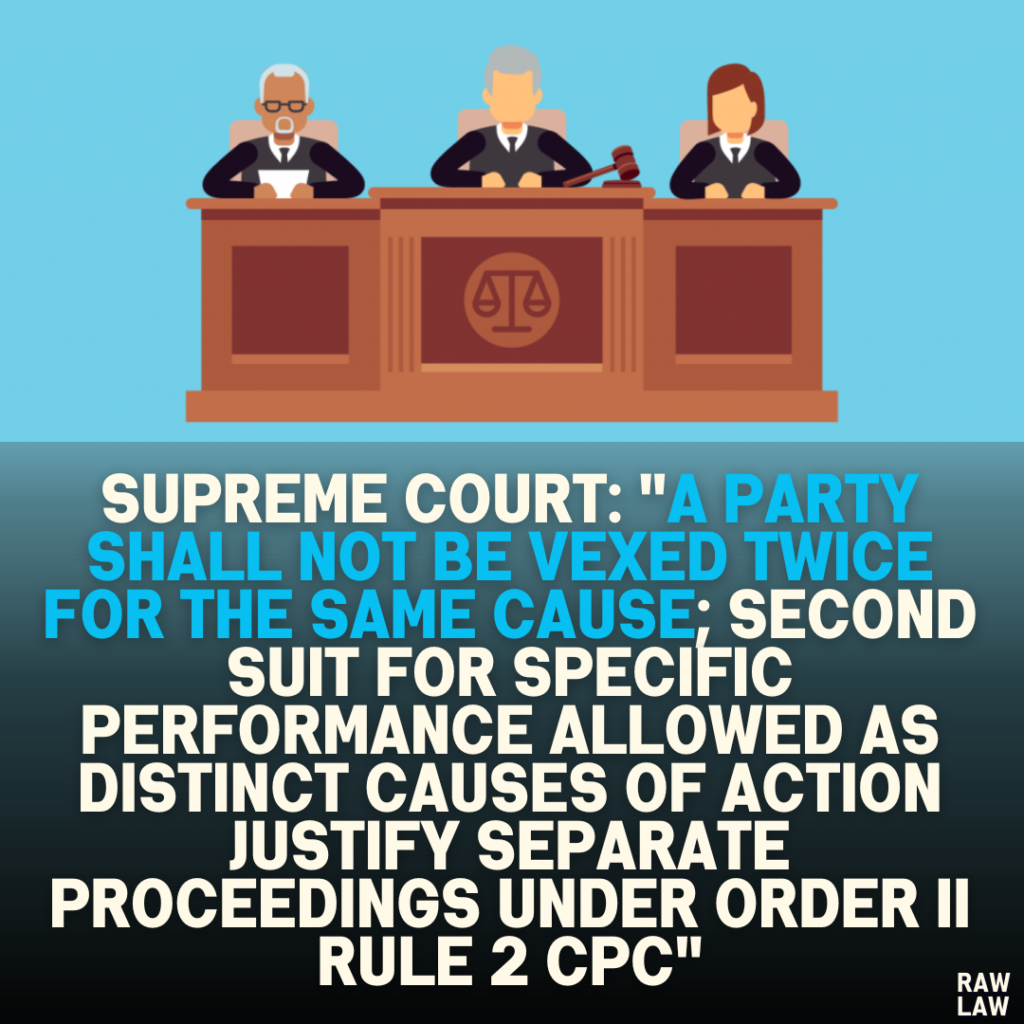1. Court’s Decision:
The Supreme Court ruled in favor of the respondent, holding that the second suit was not barred under Order II Rule 2 CPC. It emphasized:
- The two suits were based on distinct causes of action, even though they pertained to the same property.
- The respondent did not intentionally omit claims in the first suit that were later brought up in the second suit.
The Court restored the respondent’s second suit and directed the trial court to adjudicate both the suits together.
2. Facts:
The dispute arose over the sale of a property in Cuddalore, Tamil Nadu:
- Agreement for Sale (2007): The respondent entered into a sale agreement with the original owner, paid the full consideration, and obtained possession.
- Subsequent Sale Deed (2008): The original owner sold the same property to the appellant without informing the respondent.
- First Suit (2008): The respondent filed a suit for permanent injunction to prevent the appellant and the original owner from dispossessing them.
- Second Suit (2008): After learning of the subsequent sale, the respondent filed a second suit seeking:
- Specific performance of the 2007 sale agreement.
- Declaration that the 2008 sale deed in favor of the appellant was null and void.
The appellant contended that the second suit was barred under Order II Rule 2 CPC, as the respondent should have included all claims in the first suit.
3. Legal Issues:
The primary issue was whether the second suit was barred by Order II Rule 2 CPC, which mandates that all claims arising from the same cause of action should be included in a single suit unless expressly permitted otherwise by the court.
4. Petitioner’s (Appellant’s) Arguments:
The appellant argued:
- Splitting of Claims: The respondent intentionally omitted reliefs for specific performance and nullification of the subsequent sale deed in the first suit, violating Order II Rule 2 CPC.
- Knowledge of Subsequent Sale: The respondent knew about the subsequent sale deed while filing the first suit and should have sought comprehensive reliefs then.
- Precedent Support: The appellant cited earlier cases to support their claim that splitting claims undermines judicial efficiency.
5. Respondent’s Arguments:
The respondent countered:
- Distinct Causes of Action: The first suit addressed the threat of dispossession, while the second sought enforcement of contractual rights, which became apparent only after discovering the subsequent sale.
- Timeliness of Knowledge: At the time of filing the first suit, the respondent was unaware of the sale deed favoring the appellant.
- Right to File Subsequent Suit: The respondent had explicitly reserved the right to file a suit for specific performance and could not be penalized for asserting that right.
6. Analysis of the Law:
The Supreme Court examined Order II Rule 2 CPC, which aims to:
- Prevent multiplicity of suits arising from the same cause of action.
- Discourage vexatious litigation and procedural splitting of claims.
Key Legal Points Discussed:
- Cause of Action:
- It refers to the facts necessary to prove a right and seek relief.
- The Court emphasized that “cause of action” for the first suit (injunction) differed substantively from the second suit (specific performance and nullification of a sale deed).
- Tests for Applicability of Order II Rule 2:
- Whether the second suit arises from the same cause of action as the first.
- Whether the plaintiff omitted to claim relief intentionally in the first suit.
- Whether identical evidence supports both suits.
The Court concluded that the causes of action in the two suits were not identical:
- The first suit was filed to protect possession.
- The second suit emerged only after the respondent learned about the subsequent sale and required relief for contractual enforcement.
- Precedent Analysis:
- Gurbux Singh v. Bhooralal: The earlier plaint must be reviewed to determine if the subsequent claim was deliberately omitted. The Court found no deliberate omission here.
- Mohammad Khalil Khan v. Mahbub Ali Mian: If evidence for the claims differs, the causes of action are distinct.
- Intention to Relinquish Reliefs:
- The Court noted that the respondent explicitly reserved the right to file a subsequent suit for specific performance, negating any inference of deliberate omission.
- Multiplicity of Suits:
- The rule is intended to prevent unnecessary suits but does not bar legitimate subsequent claims arising from new facts.
7. Court’s Reasoning:
The Supreme Court analyzed the factual and legal basis for the second suit:
- Distinct Causes of Action:
- The first suit arose due to an immediate threat of dispossession.
- The second suit was prompted by the discovery of a subsequent sale deed.
- Respondent’s Lack of Knowledge:
- The respondent could not have sought relief for nullifying the sale deed in the first suit as they were unaware of its existence.
- Technical Bar Misapplied:
- The appellant’s reliance on Order II Rule 2 CPC was deemed inappropriate since the two suits addressed separate legal grievances.
8. Conclusion:
The Supreme Court upheld the High Court’s decision to restore the second suit, allowing it to proceed alongside the first suit. It clarified that procedural rules should not be used to deny substantive justice, especially when the causes of action are distinct.
9. Implications:
The judgment underscores:
- The importance of distinguishing causes of action in procedural objections.
- The need to balance procedural efficiency with substantive rights.
- The necessity for courts to focus on fairness and justice rather than rigid technicalities.
